বুধবার, ২৮ জানুয়ারি, ২০১৫
Planking thickness
Im not keen on either.
My father suggested a third solution which is much more elegant and Im giving it a go.
The planking is supposed to be 11/32" (Dear Mr. Gartiside, Could you not just have made it 3/8"?). Im struggling to believe Ill be able to buy the stock in such a specific dimension but I may yet be surprised.
To make the moulds I need to draw a line exactly 11/32 inside the lofted lines for each station. Dad suggested I make a cylinder of wood twice the thickness of the planking and drill a hole through the middle the width of a pencil. Then I can put the batten used to draw the station lines back using the original nail holes and run the pencil round the inside of it. The spacer will ensure that the pencil line is exactly 11/32 away from the batten.
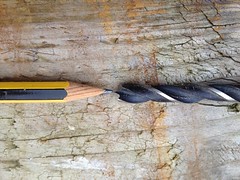 I started by breaking a pencil in half and turning it down to the thickness of the drill bit I planned to use for the hole through the spacer.
I started by breaking a pencil in half and turning it down to the thickness of the drill bit I planned to use for the hole through the spacer. 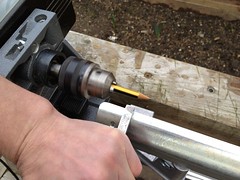 I didnt have a cylindrical pencil handy and anyway pencils appear not to come in the same sizes as drill bits (Dear pencil manufacturer, I think youre overlooking a yawning gap in the market here).
I didnt have a cylindrical pencil handy and anyway pencils appear not to come in the same sizes as drill bits (Dear pencil manufacturer, I think youre overlooking a yawning gap in the market here).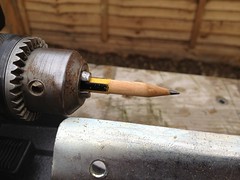 With the pencil cylindrical and precisely 7mm thick I turned my attention to an offcut of ash I had from an old project.
With the pencil cylindrical and precisely 7mm thick I turned my attention to an offcut of ash I had from an old project. 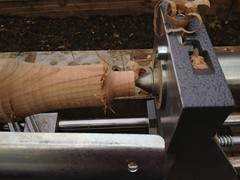 I turned this down to 11/32 using a roughing gouge, followed by a parting tool and hook gate. Once Id sawn off a short length of the cylinder I then used the conical hole the lathes dead centre leaves to centre the drill bit to make the hole for the pencil.
I turned this down to 11/32 using a roughing gouge, followed by a parting tool and hook gate. Once Id sawn off a short length of the cylinder I then used the conical hole the lathes dead centre leaves to centre the drill bit to make the hole for the pencil.I was patting on myself on the back at this point. Little more than an hour of gentle work, interrupted by a leisurely lunch, and I was a small step further along. Then I tested it. I wont share the results but if youre familiar with the gently rolling hills of South Downs you can imagine them for yourself. The hole I drilled was fractionally off centre. Barely enough to see if you looked for it. However Id turned the pencil a shade smaller than the hole in order to allow the spacer to roll around it. As it rolled it doubled the error.
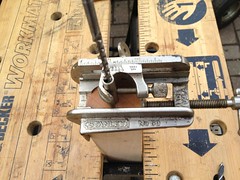
I changed my approach. For the next model the hole would be a snug fit and I would centre it much more accurately. I used a spindle I knew to be square, marked the centre and then used a dowelling gauge to make sure I was exactly in the middle when I drilled the hole. The conical dead centre of the lathe would be self-centre and ensure that as I turned the piece it would be accurate.
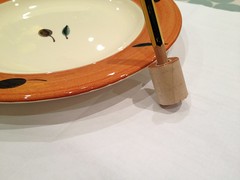 Sequence is everything.
Sequence is everything.Amid the resharpening of tools and the mountain of chips created I didnt take any pictures of the turning but here is result leaning casually against a dinner plate which served as the test batten to see if the wonder-gauge would produce a fair curve.
Judge for yourself.

এতে সদস্যতা:
মন্তব্যগুলি পোস্ট করুন (Atom)
কোন মন্তব্য নেই:
একটি মন্তব্য পোস্ট করুন